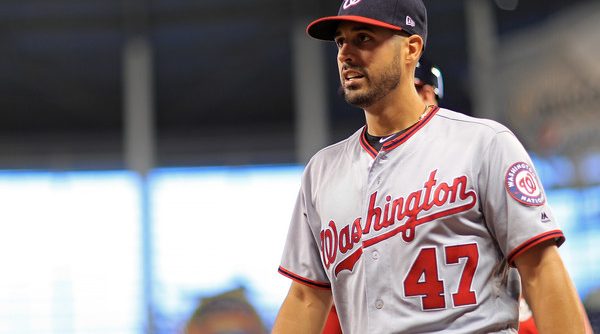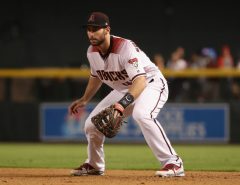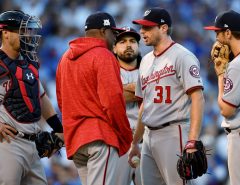In a rare crossover, Dan Zaudtke and Court Swift have teamed up to tackle some of Natstown’s hottest questions from opposite viewpoints. Enjoy!
Topic 1: Who do the Nationals target prior to the July 31st trade deadline, and who do they trade?
Dan: One of the hottest debates for the next 40-plus days will be the trade deadline. The Nats have the most obvious need in the history of baseball: bullpen help. Ken Rosenthal wrote the Nationals are eyeing two very interesting pieces in the A’s Ryan Madson and the Tigers’ Justin Wilson. The former will cost much less — most likely lower top-15 prospects. He is 36, and has another year on his 3-year, $22 million deal. He is not helping the A’s in two, three, or four years. Chelsea Janes noted a week or two ago that teams are interested in players like Wilmer Difo, Rafael Bautista, or the like for middle relievers, who are the cheapest, most available players at the deadline. Madson is averaging 94.4 on his heater, inducing a ton of soft contact with a 33.8% Soft%, versus just 19.8% Hard%. If I’m Mike Rizzo, I’m making offers and maybe overpaying a bit. Last year, the Nats traded Max Schrock for Marc Rzepczynski. Madson is older, but has a longer reputation, so I’d guess Rafael Bautista plus one of the Nats’ several high-velocity/no-command arms in Low-A would be doable.
Justin Wilson is harder to gauge. He has the vaunted “Closer” title. He has an impressive 13 K/9, but a worrisome 3.67 BB/9. The K-rate is a significant spike over his 9.38 career rate, which is also concerning. However, he’s added a slider, throwing it 11.3% of the time, while ditching the curveball. That change could be drivers behind the K-rate spike. In save situations, he has been fantastic posting an 0.63 ERA with a .102/.154/.184 slash-line against. The drawback: in non-save situations, he’s been brutal: 4.67 ERA, 250/.357/.542 slash-line against. He would be more expensive — maybe some combination of Andrew Stevenson, Sheldon Neuse, Drew Ward, or anyone not named Fedde, Robles, Kieboom (the younger), or Soto.
I salivate at the 15.25 K rate, with just 1.91 BB/9 from Tommy Kahnle of the White Sox. He may be out of the Nats’ price range — however, his price might be lower than someone with those numbers when you look at his history, including a 6.59 BB/9 last year. One other name I’d love to see the Nats pick up cheap is Aaron Hill, for one reason and one reason only: career .358/.427/.519 as a pinch hitter, including .286/.375/.429 in 16 pinch-hitting this year. Our right handed pinch hitting has been awful. Hill would be a cheap upgrade here. Finally, there has been some sentiment that prospects are for trading and rebuilding and they should all be on the table. This is a terrible idea—it’s a good way to end up with an old, expensive, bloated roster. Erick Fedde, Juan Soto, Victor Robles, and Carter Kieboom are not going anywhere.
Court: Dan just laid out some great options to bolster the bullpen without giving up any of the top prospects. While they might seem underwhelming, the fact is there just aren’t going to be many (if any) true relief aces available. I think the team should pick up one of the options above and then focus on getting more bang for their buck by adding a starting pitcher. Adding another arm to the rotation would allow Joe Ross to move the bullpen, helping that unit too. Tanner Roark showed again in his last start that he’s not the reliable option he’s been in years past. Jose Quintana of the White Sox and Sonny Gray of the A’s are young, cost-controlled, and pitch for bad teams. They both are struggling a bit this year, which could drive their trade cost down some. Either guy would not only help out this year, but down the road as well.
Other starting pitching options, like Johnny Cueto and Jeff Samardzija of the Giants and Edison Volquez of the Marlins are more expensive but also have years of control left. Cueto does have an opt-out after the year (which might not be the worst thing in the world since he’s got $84M left on his deal if he doesn’t choose free agency). In the world of baseball trades, the more expensive a guy’s contract, the less expensive his cost in prospects would be since the acquiring team would be freeing up payroll for the trading team. Adding a pitcher of Cueto’s caliber, for instance, would allow both Roark and Ross to join the bullpen come October — lessening the team’s need to overpay for a mercurial relief pitcher. In a perfect world, the Rangers would make Yu Darvish available, but all signs point to the Rangers hanging on to him in order to give them a better chance to extend him this offseason. The market for available starting pitchers will be fluid this summer considering that most teams are still in striking distance of the wild card. But as more and more teams fall further behind, more and more options will arise. I think adding a starter would be the best use of prospects and would bolster the bullpen by default.
Topic 2: Should the Expos history be honored in Washington?
Court: When Nationals break franchise records, they’re typically surpassing marks set by former Expos. Many around the District and surrounding suburbs bristle at this fact. For life-long Washingtonians, Senators records and Senators history is all that matters to them. I believe this is short-sighted. The Nationals are the Expos. Stephen Strasburg and Bryce Harper are Nationals because the franchise was ransacked by the league in the waning years in Montreal. Upon relocation, the team had no owner, no minor league system, and a pitiful major league roster. The Nats are still being hamstrung by the horrific TV deal the league struck with the Orioles to bribe Peter Angelos into voting for relocation. The Expos’ past is still very much part of the Nationals present and future. I see no harm in recognizing this. In every walk of life, it’s important to never forget where you come from.
Franchise records allow present and future generations to track a team’s history from city to city. Walter Johnson’s records belong to the Twins. Frank Howard’s records belong to the Rangers. And Vladimir Guerrero’s records belong to the Nats. For me, there is the franchise’s history and the city’s baseball history. Johnson and Hondo played in DC. They were a part of the city and made an impact on the area’s population. That will never change. The Homestead Grays of the Negro League are also part of the city’s baseball history. They split their home games between DC and Pittsburgh (both the Nats and Pirates wear Grays throw-backs) and Josh Gibson is a much a part of the city’s history as Johnson, Howard, and Zimmerman. I appreciate that the statues outside the stadium recognize the long and storied history of baseball in DC, but I also appreciate that the next home run Ryan Zimmerman hits will be the most in franchise history, passing Guerrero’s 234. History is history, whether we like it or not. Instead of ignoring the past, fans should embrace it. I would love to see the Nats wear Expos throw-backs. Lots of great baseball was played in Montreal from 1969 through 2004. Without those teams, those players, there would be no Nationals, and perhaps no baseball in Washington. The Nationals are the newest chapter in Washington baseball history, following in the Senators and Grays. But they are now, and will forever be, Expos first.
Dan: Court makes some great points in that this team was the Expos. We have the Expos records, and on Baseball Reference the franchise’s top players by WAR are all Expos. When looking at that list, it’s a travesty from a pure baseball perspective what happened to that team. They had a wild, flame-throwing lefty named Randy Johnson in 1989, and by 1994 they would become the best team in baseball with Pedro Martinez, Larry Walker, Moises Alou, Marquis Grissom, and John Wettland — Mariano Rivera’s predecessor as closer in New York. It was a fantastic team, and a well-run organization before Jeffrey Loria and MLB under Bud Selig drove that team into the ground. One of the underrated nails in the coffin was one of the most lopsided trades in baseball history: Bartolo Colon to the Expos for Grady Sizemore, Brandon Phillips, and Cliff Lee. The Expos could no longer draft well, picking relievers like Bill Bray 13th overall in 2004. Now that draft was terrible, but right after Bray were good major leaguers like Stephen Drew.
It’s sad what happened to Montreal—but their loss is our gain. I am going to disagree slightly with Court about the history. I’m glad they have Carter, Dawson et al on the walls at Nationals Park. I think we should honor and track their records: when Zimmerman hits his next homer, he will pass Guerrero, and not Howard or Harmon Killebrew or whomever. But when Andre Dawson was inducted into the Ring of Fame at Nats Park, he said: “I never played here.” DC is a funny city. With so many residents from other cities, there is always a contingent of visiting fans at all four of our major teams. With the Nationals, it’s made worse by the 33-year absence. Many native Washingtonians turned to other teams during that time — myself included. This team struggled in its first several seasons to draw fans. It lost almost 300 games over three years. Who can forget Stan Kasten openly courting Phillies fans in 2010, and subsequently having 75% Phillies fans at Opening Day that year? Michael Wilbon, among others, chastising DC as “not a sports town.”
Within the last several years, there has been a growing sense of civic pride here — especially with our sports teams. It is a major annoyance when groups like the 7 Line Army and their obnoxious group of assholes descend on our stadium and boo our players. Celebrating DC is imperative, given the demographics and the three-decade hiatus. I was at the game when they honored Frank Howard. It was an incredible event. To me it carries more weight than Dawson and Carter because he played here. Final thing I’ll say about DC Baseball History, and this is more league-wide than just DC: I wish they would do more with the Grays and the Negro Leagues. There are so many great players who we know so little about. There’s guys like James “Cool Papa” Bell, who, aside from a fantastic nickname, supposedly made Trea Turner look like Wilson Ramos. I’d love to see a “Negro League Spotlight” at games, telling a story about an unknown Negro League great, or something to that effect. In fact, before they were named the Nationals, I would tell anyone who would listen I wanted them named the Grays. I thought that would be a wonderful tribute.
Topic 3: Who’s your favorite non-star National?
Court: Maybe I’m cheating here (because this guy has a shot at the All-Star game this year) but I’m going with Gio Gonzalez. Yes, that Gio Gonzalez. I love watching him pitch — always have. I was a big fan of the trade that brought him over and despite his ups and downs, that trade might be the best Rizzo has ever made (more on that later this week). I love watching him pitch because I feel like I’m out there on the mound with him. He wears his emotions on his sleeve — for good or ill. Sometimes, maybe more than sometimes, he lets his emotions get the better of him. And when he’s able to control himself, he can be special. As the only lefty in the rotation, he provides a great change of pace when he follows Scherzer and Strasburg. He’s particularly tough on the Mets and especially the Dodgers, which will be important this fall.
But stats aside, he’s become like a goofy little brother for me. I love it when he pitches great, like he did against Texas, and I’m irrationally flustered when he doesn’t. The Good Gio/Bad Gio dichotomy should be old hat by now, but for whatever reason, for me it’s not. I keep thinking this will be the start in which he gets himself together. Maybe he’s turning a corner this year. He’s only given up more than 3 earned runs in 2 of his 17 starts so far this year. Gio Gonzalez’s addition to the club in 2012 was a huge part of the team’s success since then. He makes his starts, he stays healthy, and he’s reasonably consistent over the long haul. I know, I know… Gio Gonzalez and consistency go together like peanut butter and mayonnaise. But maybe that’s why I love him. His starts are emotional. For him. For me. For most Nats fans. Maybe I’m just a glutton for punishment. Perhaps the RFK/early-Nats Park days warped me beyond repair. I don’t really care. I love the rollercoaster Gio takes us all on every 5 days. “Buy the ticket. Take the Ride,” Hunter Thompson said about his gonzo life. Gio Gonzalez is my mescaline.
Dan: Gio has been fantastic this year — his biggest improvement has been with men on. Instead of melting down, he’s shutting the opposition down. He’s been a joy to watch — his change and curve have been lethal. I am going with someone who is only in the lineup as a result of an unfortunate injury: Michael A. Taylor. He’s really impressed me in taking over for Adam Eaton, and I wrote two pieces calling for him to be replaced by Lorenzo Cain. He’s never going to be confused with Daniel Murphy when it comes to contact rates. He’s never going to post much higher than a .300 OBP. But, when he makes contact, it’s fairly solid, with just a 14.6% soft contact rate. His .206 ISO is impressive, hopefully a sign of things to come. He’s also one of the top defensive centerfielders in the game — ranked 9th by dWAR and 10th in UZR per FanGraphs. He has made some highlight reel catches and plays while showing off a cannon arm in the recent Mets series. In previous years, he’s been a victim of an egregious TOOTBLAN or two — not quite Nook Logan, but still pretty bad. This year, FanGraphs rates him as the Nats’ second-best baserunner behind Turner. He’s an easy player to root for — a genuinely good kid. I love when he homers and FP pokes fun at his utterly innocent expression on his face. He’s always been a high-strikeout, speed/defense/power toolsy player. This year, it seems the game is slowing down for him and he’s started to put everything together. Like Gio, he could go on a crushing slump, but I have really started to enjoy watching him play — especially in the field. His bat has really started to play in the 8th slot in this stacked lineup.
Tags: Carter Kieboom, Erick Fedde, Gio Gonzalez, Joe Ross, Juan Soto, Justin Wilson, Michael Taylor, Nationals, Nats, Rafael Bautista, Ryan Madson, Tanner Roark, Victor Robles, Washington Nationals, Wilmer Difo




Leave a Reply